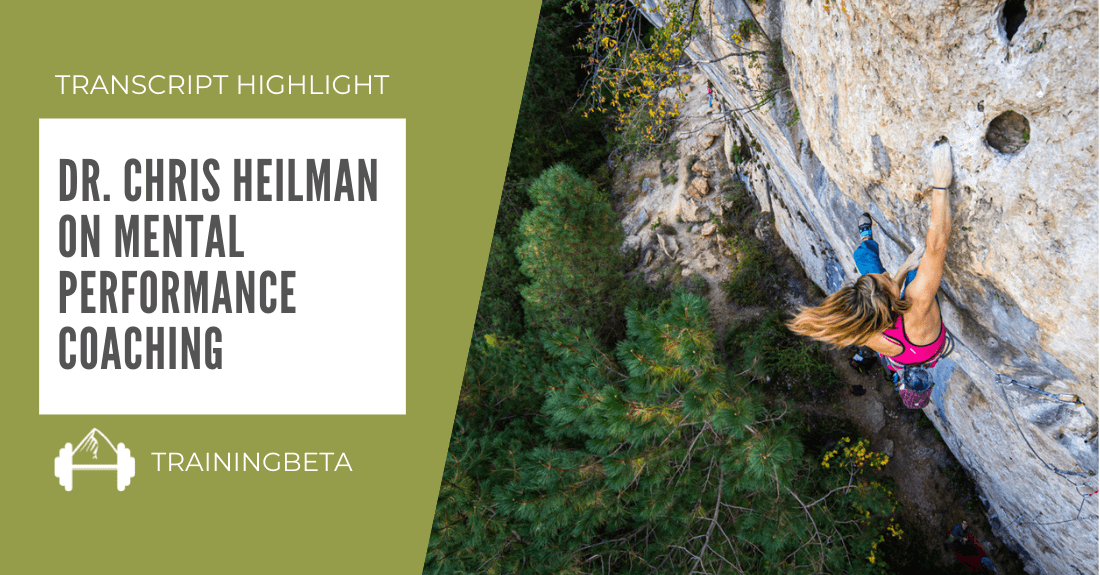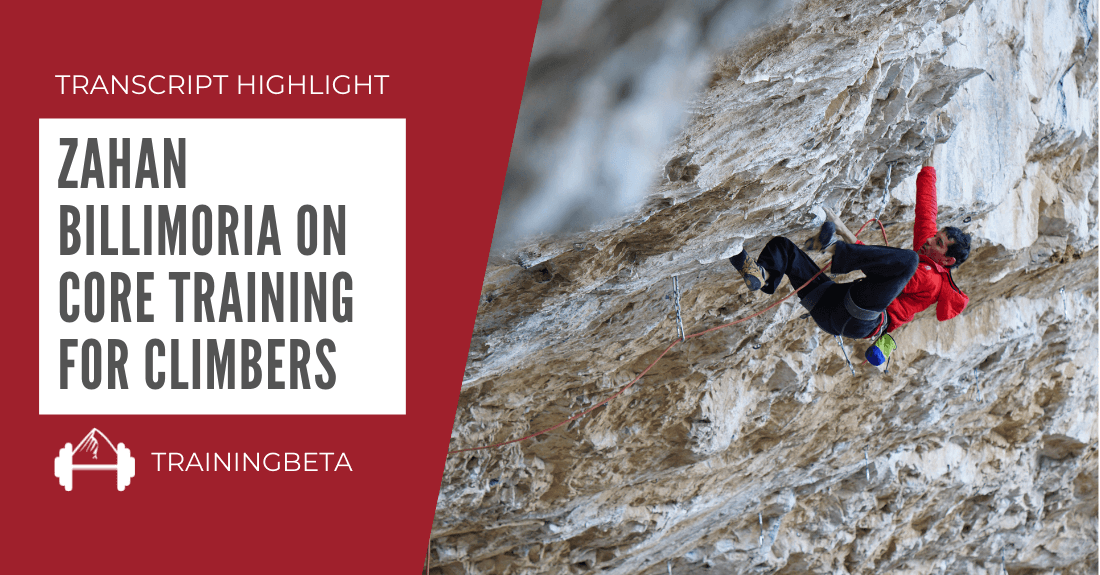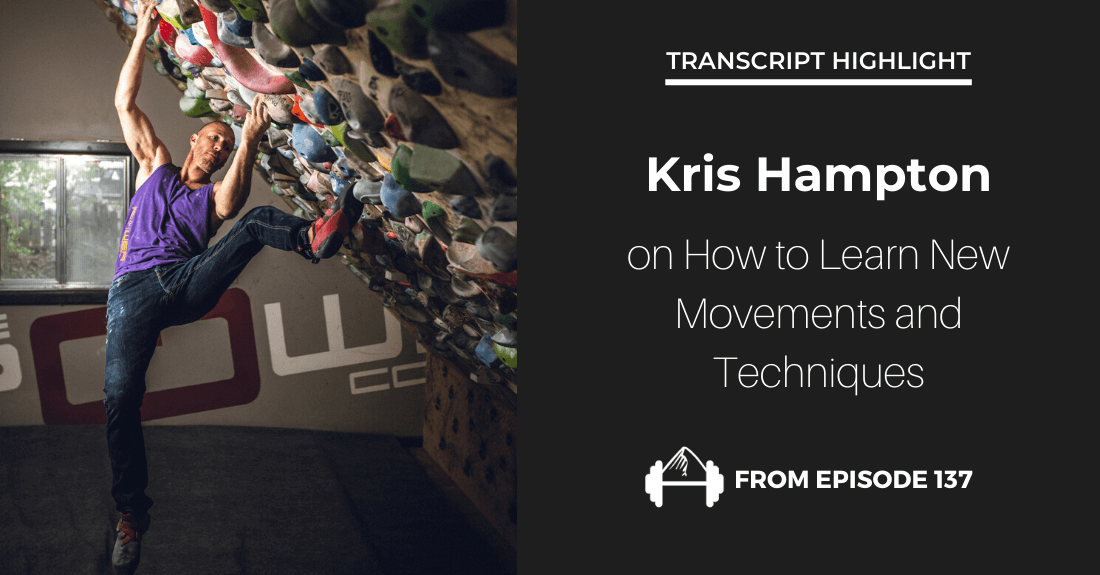Most top climbers agree that their mindset is one of the most important factors influencing their performance. Whether they are sport climbers, boulders, or comp climbers, these athletes agree that they can’t put forth their best efforts unless they have put themselves into the correct mental state first.
That sounds great, but it’s pretty abstract. What exactly does the right headspace mean and, equally importantly, what steps can we all take to get ourselves there?
Enter Dr. Chris Heilman…
Dr. Chris is a sports psychologist who works with climbers, as well as other athletes, and is one of the presenters in the Performance Climbing Coach Seminars. She has also been on the TrainingBeta Podcast several times explaining exactly how we can work on the mental side of our climbing. While there aren’t quick one size fits all solutions, there are simple concepts and techniques we can all incorporate into our climbing and daily lives that can help prepare mentally and be in more control of our mindset.
Today we have an excerpt from TrainingBeta Podcast Episode 67 where Dr. Chris outlines how staying present and calm on a climb starts with the breath. Dr. Chris not only explains how this works, but also outlines easy to follow steps to help you start making an intentional breathing practice part of your training, pre-climb ritual, and daily life.
Rember, these topics may seem abstract and certainly aren’t as quantifiable as things like training finger strength on the hangboard. That said, they are pivotal in allowing yourself to put forward your best possible efforts on climbs. Checkout Dr. Chris’ tips on staying calm and breath below and if you like what you see be sure to check out the full episode and transcript.

Dr. Chris Heilman on Starting with the Breath
Chris Heilman: Common issues among climbers, I would think, the mixing between thinking and doing. Our society really likes to multitask, but that’s really not very effective. If you think of your attention like a bottle- you have a neck in the bottle and then you have the wide base- and so within that bottle, you have all of your thoughts and they’re bouncing all around. When you get into your attention, you can only focus on one thing at a time, so that goes into that bottleneck. Only one thing can go through it at a time. Sure we can quickly change our attention to different things, but I think just understanding that you can only think about one thing at a time- so differentiating when are you thinking and when are you doing. You’re coming up with a plan at the base of your climb. Again, those three things- I like to divide a climb into a beginning, a middle, and an end. What do you have to do in the beginning, what are you going to do in the middle, what are you going to do at the end- just a general plan, and how much energy are you going to take with that. So, alright, you already have that plan for when you’re going to get on that wall, and now you’re doing. You’re clipping, you’re in a safe spot, that’s when you can look up to what you’re going to do next- make those decisions, and then turn it off and be climbing.
A lot of times I see athletes on the wall, and their head is on a swivel, and they’re looking every which way, because they’re mixing that thinking and that doing. Just really how to harness that focus.
Neely Quinn: So how do you harness it?
Chris Heilman: Well, there’s lots of strategies that you can use to harness it. I would ask clients “Have you felt this before in your daily life, and have you overcome it- what have you done?”. Really starting with a base of “you have skills”, now let’s add a different one. For example, I think meditation is awesome. It doesn’t have to be a formal meditation- it can just be sitting down and taking a minute to breathe. Turning on your phone, setting the timer for one minute, and just sit there. Just notice how many times your mind strays away, and just bringing that awareness to like “Wow, I just went down this path for however long- how can I just use my breath and just focus there and just keep bringing it back”. That’s where I would start with someone who has zero skills. Just one minute, one minute a day.
Neely Quinn: Then what? Where would you take it from there, if they’ve done that for I don’t know how long, and they feel like they’re getting somewhere with it. What do you do next?
Neely Quinn: Well- can you give me another example? To be a little bit more specific?
Chris Heilman: Sure- so say you see that person with his head on a swivel like you said. Somebody who’s thinking about all these things at once, they’re not really breathing on the wall, they’re scared, they’re worried about their beta, their footwork is bad, because they’re just nervous and worrying. You tell them, “Okay, let’s have you start this on the ground. Let’s have you start this in your life. Just breathe for one minute a day”. What should they feel like they’re getting out of it, and when do they know when to go to the next step in trying to be more controlled on the wall, and what is that next step?
Chris Heilman: Well I think breathing for that one minute and then processing it. What did that mean, what did you feel like, what happened, what did you experience? And now what do you want to experience next? “I want to feel more calm” is a great example. Alright, well how about we start breathing while you’re driving. Now you’re not just sitting there, you’re doing an activity where information is coming in, but you still feel safe, so you’re not on the wall freaking out and feeling unsafe. You may not consciously think that- it might be something more subconscious- but move that into your daily life.
Now let’s start breathing before you get on the wall, and we can start that simultaneously while you’re driving in the car, and now before you get on the wall, take five good breaths. That can even start while you’re putting on your shoes. Just calm down, focus, put on your left shoe breathing, put on your right shoe, just to really focus on the present moment, versus “I’m putting on my shoes, oh my gosh, I’m gonna climb this hard climb, what am I gonna do, I’ll be okay, it’s gonna be great”. Just really be like “Oh yeah. I’m breathing, I’m putting on my shoes”. You can only be your best if you’re present enough, and use all your strength and skills if you’re present in that moment.
Taking it from there, some people think one minute is enough, and some people might need to do some more, just to see what comes up. Does that answer your question?
Neely Quinn: Yeah- it sounds like throughout the day, you should be coming back to your breath and finding that calmness throughout every day. Then maybe that could translate onto the wall?
Chris Heilman: It definitely translates to the wall, because how you do anything is how you do everything. If you’re constantly rushed through the day, then you’re probably going to be rushed on the wall. You are living your life every day more than you are on the wall climbing, and so anything that you can do throughout the day is going to transfer if you consciously recognize that you’re doing some of this stuff to also help your climbing. We’re all strapped for time- I like to use things of our daily living to help you to be more present and mindful, so when you get on that wall, it’s a natural extension of what you just do.
Full Episode and Transcript: TBP 067 :: Sports Psychologist Chris Heilman on Breathing and Staying Calm

(Cover photo Kyle Elmquist climbing Atomic Cow 5.13d | Photo: Matt Pincus | @mpincus87)
Other Articles You Might Like:
- TBP 096 :: Sports Psychologist Chris Heilman on Imagery and Setting Realistic Goals
- Sam Elias: Level Up Your Mental Game – 6 Books
- How Breathing Can Increase Your Strength and Power
- Justen Sjong: The Art of Breathing While Climbing






Leave A Comment